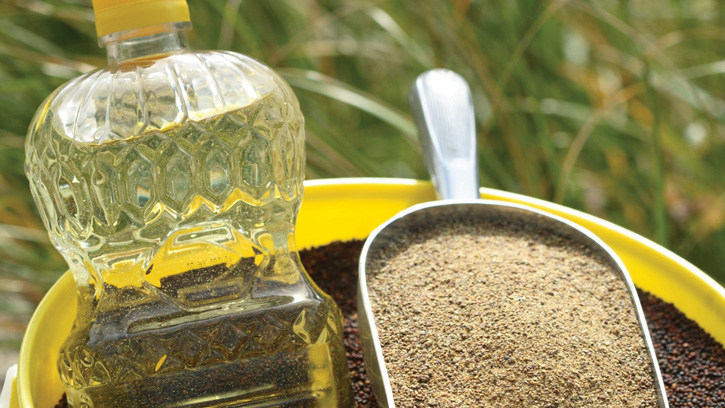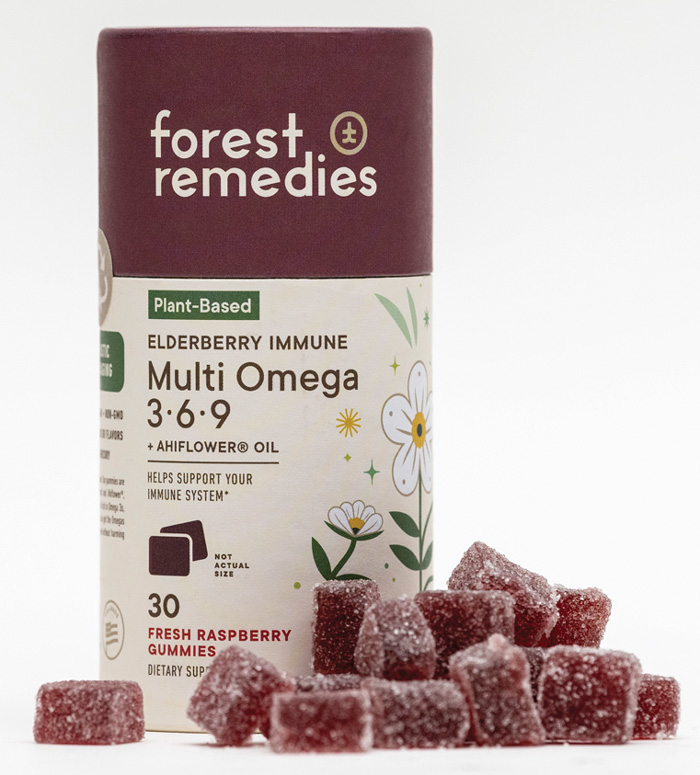Fitting in Fats
NUTRACEUTICALS
Fitting in Fats
Fat is an essential part of a healthy diet, as dietary fats contribute to cell growth, energy, and nutrient absorption. But amount and types of fat are important to watch, and more consumers are doing so. Cargill’s FATitudes 2020 research indicated that 68% of consumers worldwide are closely monitoring the type and amount of fat and oil in their packaged food. Closely reading labels guides their purchasing decisions.
A “no saturated fat” claim is the most influential, with 53% of consumers in 2020 saying they are more likely to purchase these products. “That exceeds other label claims, including non-genetically modified (GMO), which remains a prime consideration with four in 10 consumers (44%),” says Jamie Mavec, marketing manager, Cargill.
Beyond avoiding saturated fat, consumers are also looking for “good” fats, oils, and fatty acids. They have a growing awareness that certain fats and fatty acids can be beneficial for their brain, heart, eyes, and weight. Here’s a look at some of the areas where fats fit in.
Weight Management
It may seem a bit of a paradox, but some fat can play a role in weight management. Diets like the ketogenic diet focus on the increased consumption of specific fats to help lose weight and promote satiety, including avocado oil, olive oil, coconut oil, and medium-chain triglycerides (MCTs).
MCTs, usually extracted from coconut oil, have been associated with weight loss through increased energy expenditure and lipid oxidation. Mumme and Stonehouse (2015) indicated that replacing long-chain triglycerides (LCTs) with MCTs in the diet could potentially induce modest reductions in body weight and composition without adversely affecting lipid profiles. The meta-analysis showed that compared with LCTs, MCTs decreased body weight, waist circumference, hip circumference, total body fat, total subcutaneous fat, and visceral fat. Further research was recommended to confirm the efficacy and determine dosages.
A fat alternative made by food technology company Epogee, EPG (esterified propoxylated glycerol) can be used to lower the calorie content of foods and beverages. EPG begins as GMO-free rapeseed oil. After splitting the oil into its components (glycerin and fatty acids), a food-grade propoxyl connecter is inserted, and the glycerin and fatty acids are relinked to create a fat ingredient that resists digestive enzyme action, thereby inhibiting caloric release during digestion.
Labeled as EPG (modified plant-based oil), it has 0.7 cal/g versus 9 cal/g for regular fat. As an ingredient, it can cut up to 92% of calories from fat without compromising taste, texture, or functionality, the company says. Backed by 65 safety studies, it is currently used in products in categories such as ice cream (N!cks’s), nut butters (Own Your Hunger), and chocolate (Sweet Nothings). In June, DoJo Brands released a line of better-for-you chocolate bars using EPG. DoJo’s Gatsby chocolate bars have fewer than half the calories of regular chocolate bars and about one-quarter the sugar.
Heart Health
Replacing saturated fats with unsaturated fats is widely known to be heart healthy. “The best evidence supports substituting saturated fatty acids with polyunsaturated fatty acids as it relates to cardiovascular health benefits,” says Patricia Williamson, principal scientist, scientific and regulatory affairs, Cargill. “The 2005 dietary reference intakes (DRI) recommend 5% to 10% of energy from polyunsaturated fatty acids, and this recommendation remains unchanged in the recent 2015–2020 DRI publication.”
The American Heart Association (AHA) suggests four ways to get good fats: eating fatty or oily fish twice a week, eating about 1 oz of unsalted nuts and seeds, adding avocado to the diet, and using oils like avocado, canola, corn, flaxseed, olive, peanut, safflower, sesame, soybean, and sunflower. With oils, AHA says that, in general, choose those with less than 4 g of saturated fat per tablespoon, and no partially hydrogenated oils or trans fats.
Olive oil is a primary fat source in the Mediterranean diet, which has been associated with benefiting heart health. Guasch-Ferré et al. (2020) noted that higher olive oil intake (>0.5 tablespoon/day or >7 g/day) was associated with lower risk of coronary heart disease (CHD) and total cardiovascular disease (CVD) in two large prospective cohorts of U.S. men and women. In addition, replacing 5 g/day of margarine, butter, mayonnaise, or dairy fat with the equivalent amount of olive oil was associated with 5% to 7% lower risk of total CVD and CHD.
Canola oil is a source of omega-6 polyunsaturated fatty acids and alpha-linolenic acid (ALA), an omega-3 fatty acid. Like olive oil, it is rich in monounsaturated fat. In November 2018, the U.S. Food and Drug Administration (FDA) determined there was credible evidence to support a qualified health claim that consuming oleic acid in edible oils, such as sunflower or canola oil, may reduce the risk of CHD. Edible oils must contain at least 70% oleic acid to meet the criteria for this qualified health claim, explains Williamson.
“The FDA based its decision on research that suggested a relationship between consuming oils with high levels of oleic acid and improved cholesterol levels, which it said indicated a reduced risk for coronary heart disease. The agency noted the studies it reviewed only showed beneficial heart effects when the oleic acid–containing oils replaced fats and oils that were higher in saturated fats,” she says.
Cargill offers high oleic sunflower oil and high oleic canola oil, both of which meet the FDA’s qualified health claims. These oils, which are low in saturated fat, offer a number of other benefits, including high stability, superior performance, longer fry life, and a neutral flavor, says Cargill marketing manager Mavec.
In addition to oils, phytosterols are natural fat components in plants that have structures similar to cholesterol. Because of this, they compete with cholesterol for absorption in the digestive system, ultimately blocking cholesterol absorption and aiding in blood cholesterol reduction. An FDA-approved health claim on phytosterols states, “Foods containing at least 0.65 g per serving of vegetable oil plant sterol esters, eaten twice a day with meals for a daily total intake of at least 1.3 g, as part of a diet low in saturated fat and cholesterol, may reduce the risk of heart disease.”
Omega-3 fatty acids docosahexaenoic acid (DHA) and eicosapentaenoic acid (EPA) have also been shown to contribute to heart health, helping to maintain healthy blood pressure and healthy triglyceride levels. Bernasconi et al. (2020) conducted a meta-analysis to determine whether supplementation with EPA and DHA resulted in reduced CVD risk. They concluded that considering the relatively low costs and side effect profiles of omega-3 supplementation and the low drug-drug interactions with other standard therapies used in primary and secondary CVD prevention, clinicians and patients should consider the potential benefits of omega-3 (EPA/DHA) supplementation, especially using 1,000 to 2,000 mg/day dosages.
Brain Health
In addition to heart health, omega-3 fatty acids are linked to brain health, as DHA makes up a portion of the fat in the brain and has been shown to have neuroprotective properties. Research has shown an impact of omega-3s on cognitive function and memory, symptoms of depression, ADHD, and recovery from traumatic brain injuries.
Most recently, omega-3 and omega-6 fatty acids have been suggested to potentially help with headache reduction in adults with migraines (Ramsden et al. 2021). Adults with chronic and episodic migraines were randomized to an H3 diet (increased EPA+DHA), an H3-L6 diet (increased EPA+DHA, reduced linoleic acid), or a control diet (average U.S. intake of omega-3 and omega-6 fatty acids). While the benefit of both test diets on quality of life was inconclusive, the reduction in headaches was robust, particularly for the H3-L6 diet.
In a review of 25 randomized controlled trials, Alex et al. (2020) suggested that long-chain omega-3 polyunsaturated fatty acid supplementation could provide a mild benefit in improving memory function in non-demented older adults. In a separate meta-analysis of 29 studies focusing on youth, Emery et al. (2020) identified beneficial effects of EPA-rich formulations in the domains of long-term memory, working memory, and problem solving, along with a tendency toward beneficial effects in clinical rather than non-clinical populations.
Brain cell membranes are also rich in two phospholipids: phosphatidylserine and phosphatidylcholine. Schverer et al. (2020) reviewed some human and preclinical studies showing the positive impact of phospholipid-enriched diets on cognitive processes in health and disease. Some studies saw better cognitive performances in adults associated with phospholipid consumption. In addition, a diet enriched in phospholipids was shown to reduce stress-induced cognitive deficits (Boyle et al. 2019).
Preterm Births
Omega-3 fatty acids have already been shown to be important for infant development, particularly for brain and eye development. Carlson et al. (2021) recently demonstrated another potential benefit of omega-3 DHA: reducing early preterm birth in women with low DHA status. Women with singleton pregnancies and 12 to 20 weeks gestation were included in the study. Some took a higher dose of DHA (1,000 mg Life’s DHA-S oil from DSM Nutritional Products) and others a lower dose (200 mg). The higher dose group had a lower early preterm birth rate, especially if participants had low DHA status at enrollment. The authors suggested that clinicians could consider prescribing 1,000 mg DHA daily during pregnancy to reduce early preterm birth in women with low DHA status.
Eye Health
In addition to the brain, DHA is also found in the retina of the eye. Research has shown that both EPA and DHA are important for visual development and may help reduce symptoms of dry eye syndrome in adults.
An interesting survey of optometrists in Australia and New Zealand looked at their attitudes and practice behaviors related to omega-3 fatty acids for eye health. Based on an anonymous online survey, Zhang et al. (2020) reported that most respondents (79%) indicated recommending that their patients consume omega-3 fatty acids to improve their eye health. Sixty-eight percent of respondents indicated recommending omega-3-rich foods for age-related macular degeneration management, while 62% indicated recommending omega-3 supplements. Most respondents (78%) indicated recommending omega-3-rich foods or supplements for dry eye disease.
Inflammation
An up-and-coming oil, Ahiflower oil (Natures Crops International) is a sustainable, vegan source of the omega-3 fatty acids stearidonic acid and ALA, omega-6 fatty acids gamma-linolenic acid and linoleic acid, and omega-9 oleic acid, some of which have been shown to support a healthy inflammatory response. Lefort et al. (2017) demonstrated that consumption of Ahiflower oil was associated with an increase in interleukin-10 (anti-inflammatory cytokine) production in healthy subjects. IL-10 is part of the body’s natural response to resolving acute inflammation, for example, post-exercise or from immune challenges.
Ahiflower’s omega benefits have recently been added to Forest Remedies’ two new functional gummy supplements. Thanks to Ahiflower oil, the gummies deliver a vegan source of omega-3, -6, and -9 fatty acids. Multi Omega 3-6-9 + Ahiflower Oil supports heart, brain, skin, and joint health and Elderberry Immune Multi Omega 3-6-9 + Ahiflower Oil provides immune and wellness support.
A variety of functional fats, oils, and fatty acids provide opportunities for formulators to address specific health concerns, such as those related to immunity, in addition to overall wellness.
REFERENCES
Alex, A., K. A. Abbott, M. McEvoy, et al. 2020. “Long-chain Omega-3 Polyunsaturated Fatty Acids and Cognitive Decline in Non-demented Adults: A Systematic Review and Meta-analysis.” Nutr. Rev. 78(7): 563–578.
Bernasconi, A., M. M. Wiest, C. J. Lavie, et al. 2020. “Effect of Omega-3 Dosage on Cardiovascular Outcomes.” Mayo Clinic Proceedings 96(2): 304–313.
Boyle, B., L. Dye, K. Arkbåge, et al. 2019. “Effects of Milk-based Phospholipids on Cognitive Performance and Subjective Responses to Psychosocial Stress: A Randomized, Double-blind, Placebo-controlled Trial in High Perfectionist Men.” Nutrition 57: 183–193.
Carlson, S. E., B. J. Gajewski, C. J. Valentine, et al. 2021. “Higher Dose Docosahexaenoic Acid Supplementation During Pregnancy and Early Preterm Birth: A Randomised, Double-blind, Adaptive-design Superiority Trial.” EClinical Medicine. Published by The Lancet. Volume 36: 100905. DOI:https://doi.org/10.1016/j.eclinm.2021.100905.
Emery, S., I. Häberling, G. Berger, et al. 2020. “Omega-3 and its Domain-specific Effects on Cognitive Test Performance in Youths: A Meta-analysis.” Neurosci. Biobehav. Rev. 112: 420–436.
Guasch-Ferré, M., G. Liu, Y. Li, et al. 2020. “Olive Oil Consumption and Cardiovascular Risk in U.S. Adults.” J. Am. Coll. Cardiol. 75(15): 1729–1739.
Lefort, N., R. LeBlanc, and M. E. Surette. 2017. “Dietary Buglossoides Arvensis Oil Increases Circulating n-3 Polyunsaturated Fatty Acids in a Dose-Dependent Manner and Enhances Lipopolysaccharide-Stimulated Whole Blood Interleukin-10 – A Randomized Placebo-Controlled Trial.” Nutrients 9(3): 261.
Mumme, K. and W. Stonehouse. 2015. “Effects of Medium-chain Triglycerides on Weight Loss and Body Composition: A Meta-analysis of Randomized Controlled Trials.” J. Acad. Nutr. Diet 115(2): 249–263.
Ramsden, C. E., D. Zamora, K. R. Faurot, et al. 2021. “Dietary Alteration of n-3 and n-6 Fatty Acids for Headache Reduction in Adults with Migraine: Randomized Controlled Trial.” BMJ 374: n1448.
Schverer, M., S. M. O’Mahony, K. J. O-Riordan, et al. 2020. “Dietary Phospholipids: Role in Cognitive Processes Across the Lifespan.” Neuroscience & Biobehavioral Reviews 111: 183–193.
Zhang, A. C., S. Singh, J. P. Craig, et al. 2020. “Omega-3 Fatty Acids and Eye Health: Opinions and Self-reported Practice Behaviors of Optometrists in Australia and New Zealand.” Nutrients 12(4): 1179.








